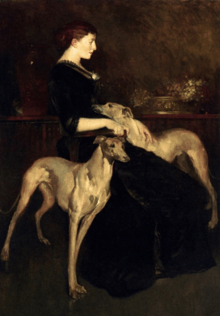Mary Anna Draper
Mary Anna Draper, also known as Mary Anna Palmer Draper, (September 19, 1839 – December 8, 1914)[lower-alpha 1] was an American, known for her work with her husband, Henry Draper, with astronomical photography and research.[3] She helped found the Mount Wilson Observatory and created an award for astronomical research, the Henry Draper Medal of the National Academy of Sciences.

Early life
Mary Anna Palmer was born in 1839, in Stonington, Connecticut, to Mary Ann Suydam and Courtlandt Palmer.[3][4] Her father was a merchant and real estate investor. At his death in 1874, he left her and her three brothers a large fortune.[3]
In 1867, she married Henry Draper, a physician and professor of chemistry and physiology at University of the City of New York, now New York University. Particularly interested in astronomical spectroscopy, he was also a skilled amateur astronomer.[3][4]
Career
Draper developed an interest in astronomy from her husband and the two took the first photographs of the spectrum of a star using a large telescope Henry built at his observatory near their summer home in Hastings-on-Hudson, New York in 1872.[3][5] The couple traveled to Rawlins, Wyoming to observe a solar eclipse in 1878. During winters, the couple worked in the laboratory connected to their New York City home. For fifteen years, the Drapers worked together on observations, photography, and laboratory work.[3] In the process, she became an expert technician.[4]
After the death of her husband in 1882, she donated her equipment to the Harvard College Observatory, and endowed the Henry Draper Memorial to fund the continuation of her research. Although she no longer actively researched, she visited the observatory regularly to learn about the progress of the research.[6] The monies that she donated allowed Edward Charles Pickering of the university to classify stars based upon characteristics found in photographs of the spectra of stars. Her influence has resulted in women astronomers working at the observatory;[4] amongst them Henrietta Swan Leavitt, whose work on Cepheid variable stars lead to their use as important galactic distance indicators.
She also created an award for astronomical research, the Henry Draper Medal of the National Academy of Sciences, and helped to found the Mount Wilson Observatory.[6][7] She hosted scientific lectures and exhibitions at her home laboratory, and continued until her death of pneumonia in 1914[3] in New York City.[4]
Following her death, a bequest was made in her name to the Metropolitan Museum of Art of her extensive collection of Egyptian artifacts, Classical antiquities, tapestries, 22 miniature paintings, and other works of art.[4][8] She also made a bequest for the continued research at the Harvard Observatory.[5]
Notes
References
- John Arthur Garraty; Mark Christopher Carnes (January 1, 1999). American National Biography: Dafora-Dubuclet. Oxford University Press. p. 883. ISBN 978-0-19-512785-0.
- "Mary Anna "Annie" Palmer Draper". Find a Grave. Retrieved February 1, 2017.
- Proffitt, Pamela (1999-01-01). Notable Women Scientists. Gale Group. ISBN 9780787639006.
- Marilyn Bailey Ogilvie (1986). Women in Science: Antiquity Through the Nineteenth Century : a Biographical Dictionary with Annotated Bibliography. MIT Press. p. 75. ISBN 978-0-262-65038-0.
- J. B. Hearnshaw (April 19, 1990). The Analysis of Starlight: One Hundred and Fifty Years of Astronomical Spectroscopy. CUP Archive. pp. 105–106. ISBN 978-0-521-39916-6.
- Woodman, Jenny. "The Women 'Computers' Who Revolutionized Astronomy". The Atlantic. Retrieved 3 December 2016.
- United States Congressional serial set. 1909. pp. 57–62.
- The Bulletin of the Metropolitan Museum of Art. Metropolitan Museum of Art. 1915. pp. 57, 83, 84, 94–97.
External links
- Mary Anna Palmer Draper, Harvard College Observatory History